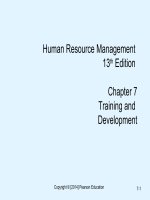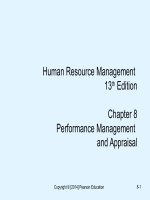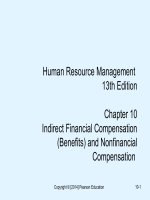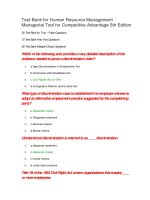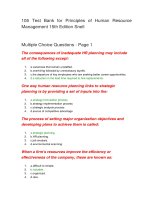Human resource management mondy 13th edition chapter 10
Bạn đang xem bản rút gọn của tài liệu. Xem và tải ngay bản đầy đủ của tài liệu tại đây (426.72 KB, 69 trang )
Human Resource Management
13th Edition
Chapter 10
Indirect Financial Compensation
(Benefits) and Nonfinancial
Compensation
Copyright © [2014] Pearson Education
10-1
Learning Objectives
• Describe some unique employee benefits, define
indirect financial compensation (benefits), and
explain what is included in a total reward package.
• Describe legally required benefits.
• Define discretionary benefits and explain the various
types of discretionary benefits.
• Explain the different kinds of health care legislation
and describe the relationship between smoke-free
workplaces and the Patient Protection and
Affordable Care Act.
• Explain premium pay.
Copyright © [2014] Pearson Education
10-2
Learning Objectives (Cont.)
• Explain voluntary benefits.
• Describe customized benefit plans.
• Describe the importance of communicating
information about the benefits package.
• Describe the job itself and the job environment
as components of nonfinancial compensation.
• Describe workplace flexibility (work-life balance)
factors and global customized benefits.
Copyright © [2014] Pearson Education
10-3
HRM in Action: Unique Employee
Benefits
• More and more companies are
providing unique benefits
• Companies were trying out use of
unique benefits
• Used employee benefits to clearly
differentiate them from their competitors
Copyright © [2014] Pearson Education
10-4
Indirect Financial Compensation
(Benefits)
All financial rewards that are not paid
directly to the employee
Copyright © [2014] Pearson Education
10-5
Discretionary Versus Voluntary
Benefits
• Discretionary benefits: Benefits made as
a result of unilateral management
decisions in nonunion firms and from
labor–management negotiations in
unionized firms
• Voluntary benefits: Usually entirely paid
by employee, but employer typically pays
administrative cost
Copyright © [2014] Pearson Education
10-6
Indirect Financial Compensation (Benefits)
in a Total Compensation Program
External Environment
Internal Environment
Compensation
Direct
Financial
Indirect (Benefits)
Nonfinancial
The Job
Job Environment
Legally Required Benefits
Social Security
Unemployment Compensation
Workers’ Compensation
Discretionary Benefits
Payment for Time Not Worked
Health
Care
Life
Insurance
Retirement
Plans
Disability Protection
Employee Stock Option Plans
Employee Services
Premium Pay
Voluntary Benefits
Copyright © [2014] Pearson Education
10-7
Total Rewards
• All ways in which people are rewarded
when they come to work
• Pay, benefits, and other non-financial
rewards
• Put together to make coherent and
integrated whole
• Directed toward maximum attainment of
corporate goals
• All items that add value to an employee
Copyright © [2014] Pearson Education
10-8
Mandated Benefits
(Legally Required)
• Social Security
• Unemployment compensation
• Workers’ compensation
Copyright © [2014] Pearson Education
10-9
Social Security
• System of retirement benefits
• Federal payroll tax to fund
unemployment and retirement benefits
• Amendments include disability
insurance, survivors’ benefits, and
Medicare
Copyright © [2014] Pearson Education
10-10
Unemployment Compensation
• Laid off individual receives
compensation for up to 26 weeks
• Administered by states
• Payroll tax paid solely by employers
Copyright © [2014] Pearson Education
10-11
Workers’ Compensation
• Expenses resulting from job-related
accidents or illnesses
• Administered by states
• Program paid for by employers
• Premium expense directly tied to past
experience
Copyright © [2014] Pearson Education
10-12
Discretionary Benefits
•
•
•
•
•
•
•
Payment for time not worked
Health care
Life insurance
Retirement plans
Disability protection
Employee stock option plans (ESOP)
Employee services
Copyright © [2014] Pearson Education
10-13
Payment for Time Not Worked:
Paid Vacations
• Provide workers with opportunity to rest,
become rejuvenated, and thus more
productive
• Encourage employees to remain with firm
• Typically increases with seniority
• Americans do not take full advantage of
their vacation benefits
Copyright © [2014] Pearson Education
10-14
Payment for Time Not Worked: Sick
Pay and Paid Time Off
• Many firms allocate each employee a
certain number of days of sick leave per
year
• Some managers are very critical of sick
leave programs
• Paid time off (PTO): Certain number of
days off provided each year that
employees can use for any purpose
Copyright © [2014] Pearson Education
10-15
Results-only Work Environment
• Allows employees to work wherever and
whenever they wish as long as they
complete projects on time
• There is no schedule and no limit for
earned vacation and leave time
Copyright © [2014] Pearson Education
10-16
Payment for Time Not Worked:
Sabbaticals
• Temporary leaves of absence from
organization, usually at reduced pay
• Used in academic community for years
• Recently entered the private sector
• Help reduce turnover and prevents
burnout
Copyright © [2014] Pearson Education
10-17
Payment for Time Not Worked:
Other Forms
•
•
•
•
•
•
•
Perform civic duties
Handle personal affairs
Jury duty
National Guard or military reserve
Voting time
Bereavement time
Rest periods, coffee breaks, lunch periods,
cleanup time, and travel time
Copyright © [2014] Pearson Education
10-18
Factors Contributing to the High
Cost of Health Care
• Aging population
• Growing demand for medical care
• Increasingly expensive medical
technology
• Inefficient administrative processes
Copyright © [2014] Pearson Education
10-19
Forms of Managed-Care Health
Organizations
• Health maintenance organizations (HMOs)
cover all services for fixed fee, but exercise
control over which doctors and health
facilities member may use.
• Preferred provider organizations (PPOs)
are managed-care health organizations
where incentives are provided to members to
use services within system; out-of-network
providers may be used at greater cost.
Copyright © [2014] Pearson Education
10-20
Forms of Managed-Care Health
Organizations (cont.)
• Point-of-service (POS) requires a primary
care physician and referrals to see
specialists, as with HMOs, but permits out-ofnetwork health care access.
• Exclusive provider organizations (EPOs)
offer smaller PPO provider network and
usually provide few, if any, benefits when outof-network provider is used.
Copyright © [2014] Pearson Education
10-21
Consumer-Driven Health
Care Plans
• Each employee given set amount of money
annually with which to purchase health care
coverage
• Involves high-deductible insurance coverage
combined with a tax-advantaged account like
a health saving account (HRA), health
reimbursement accounts (HRA), and
flexible saving account (FSA)
Copyright © [2014] Pearson Education
10-22
Health Savings Account (HSA)
• Tax-free health spending and savings
account
• Available to individuals and families who
have qualified high-deductible health
insurance policies as determined by IRS
• Can put a maximum of $6,250 a year in a
pretax account
• Not use HSA for over-the-counter drugs
Copyright © [2014] Pearson Education
10-23
Health Reimbursement Accounts
• Allow employer to set aside funds to
reimburse medical expenses paid by
participating employees
• No limit on employer’s contributions
• Can be rolled over from year to year
Copyright © [2014] Pearson Education
10-24
Flexible Spending Account (FSA)
• Health benefit plan established by
employers
• Allows employees to deposit certain portion
of pre-tax salary into account to be used for
eligible expenses (Maximum - $2,500)
• Forfeit any amount left unspent in account
at year end
• Not used for over-the-counter medications
Copyright © [2014] Pearson Education
10-25


